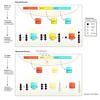Filter my results


This diagram shows the life cycle of Neurospora crassa, a mold that grows on bread. N.
Neurospora crassaMicrobiologyMicroscopyGrowthdevelopment
Between 1934 and 1945, George Beadle developed a hypothesis that each gene within the chromosomes of organisms each produced one enzyme.
CellsGeneticsEnzymesGenesAmino Acids
In 1935, George Beadle and Boris Ephrussi developed a technique to transplant optic discs between fruit fly larvae.
Fruit-fliesImaginal DisksGeneticsdevelopmentMetamorphosis, Biological
Neurospora crassa is a red mold that scientists use to study genetics. N.
Neurospora crassaMicrobiologyMicroscopyCulture MediaMolds
In the 1930s, George Beadle and Boris Ephrussi discovered factors that affect eye colors in developing fruit flies.
Fruit-fliesImaginal DisksGeneticsdevelopmentMetamorphosis, Biological
Hans Asperger studied mental abnormalities in children in Vienna, Austria, in the early twentieth century. Asperger was one of the early…
Asperger's syndromeMental HealthPsychiatryChild psychiatryWorld Health Organization
In 1942, the United States Supreme Court Case of Skinner v. Oklahoma ruled that states could not legally sterilize those inmates of prisons deemed…
LawCompulsory SterilizationSupreme Court DecisionsEugenicsInvoluntary Sterilization
Aristotle studied developing organisms, among other things, in ancient Greece, and his writings shaped Western philosophy and natural science for…
GreecedevelopmentphilosophyPlatoPhysics
Julia Barlow Platt studied neural crests in animal embryos and became involved in politics in the US during the nineteenth and twentieth centuries.…
DogfishNeural CrestNervous SystemCartilageGerm Layers
The hedgehog signaling pathway is a mechanism that regulates cell growth and differentiation during embryonic development, called embryogenesis, in…
Drosophila melanogasterCyclopiaGenetic regulationZebra danioGenes